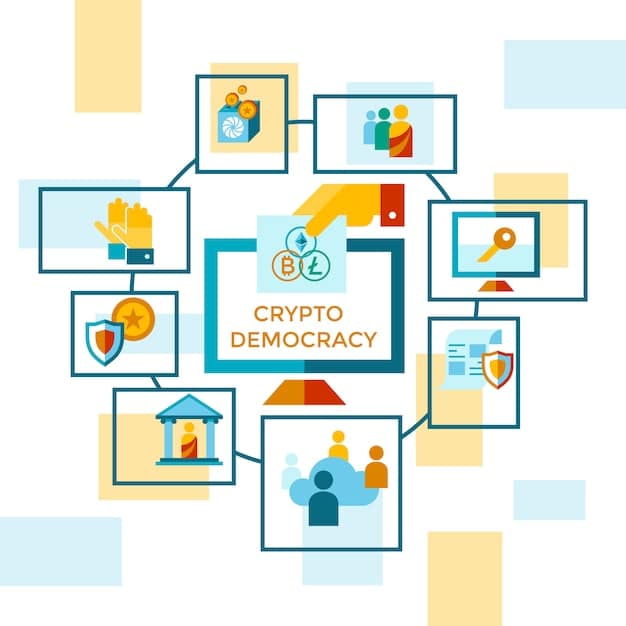Altcoin Governance: Decentralization and Decision-Making Models

Altcoin governance models are crucial for understanding how these digital assets operate, focusing on decentralization and decision-making processes to evaluate their potential and long-term sustainability in the cryptocurrency market.
Understanding altcoin governance models: evaluating the decentralization and decision-making processes of different projects is crucial for anyone looking to invest in or build on these alternative cryptocurrencies. These models dictate how developmental decisions, funding allocations, and protocol upgrades are handled, thereby impacting the long-term viability and success of the projects.
Understanding Altcoin Governance Models
Altcoin governance is the backbone of various projects, determining their sustainability and community involvement. Exploring different models allows us to see how decisions are made and implemented.
Decentralization is a key aspect of governance, referring to the distribution of power among network participants. This can involve token holders, developers, or specialized governance bodies. A well-structured governance model is critical for fostering trust and commitment within the community, promoting active participation and a sense of shared ownership.

Governance models can vary widely. Some projects adhere to a purely decentralized approach, where token holders democratically vote on proposals, while others adopt a more centralized model involving a core team or foundation that oversees key decisions. Each approach comes with its own set of advantages and disadvantages, including trade-offs between efficiency and inclusivity.
The Importance of Decentralization in Altcoin Governance
Decentralization is often hailed as a core tenet of blockchain technology, but its practical implementation in altcoin governance models varies widely. Understanding these differences is crucial for evaluating the resilience and future prospects of various projects.
A highly decentralized governance model typically involves a broad distribution of decision-making power among token holders. This can ensure that no single entity can unilaterally control the direction of the project, reducing censorship and single-point-of-failure risks.
Benefits of Decentralized Governance
Decentralized governance offers several potential benefits, although it also comes with its own challenges.
- Increased security and resilience
- Enhanced community participation and ownership
- Mitigation of conflicts of interest
However, achieving true decentralization is not without its difficulties. Airdrops, early investor allocations, and centralized exchanges can result in a concentration of token holdings, undermining the desired distribution of power.
Centralized Governance Models and Their Implications
While decentralization is the aim for many altcoins, centralized governance models also exist and offer their own advantages and challenges. In centralized systems, decision-making is typically handled by a core team or a foundation, potentially streamlining development and implementation.
Centralized models can be more efficient in making quick decisions and implementing necessary upgrades. A clear chain of command can lead to faster responses to emerging issues or market opportunities.

However, centralized governance models can also be susceptible to corruption or misalignment of interests. If decision-makers prioritize their own gains over the community’s interest, the project’s long-term sustainability could be jeopardized.
Decision-Making Processes in Altcoin Governance
The specific decision-making processes employed by an altcoin governance model can significantly impact the project’s development and adaptability. These processes can range from simple token holder voting to more complex systems involving delegated governance or futarchy.
Token holder voting is the most common method. Token holders can submit proposals for consideration, and those proposals are then voted on by the community. The weight of each vote is usually proportional to the number of tokens held.
Evaluating the Effectiveness of Altcoin Governance Models
Assessing the effectiveness of an altcoin governance model involves considering several factors, including active community participation, transparent decision-making, and efficient implementation of proposals.
Active community participation is crucial for ensuring that the governance process is truly representative. A high level of engagement indicates that the community is invested in the project’s success and that different perspectives are being considered.
Key Metrics for Evaluation
- Voter turnout rates
- Frequency of proposals
- Diversity of viewpoints in discussions
Transparency is also essential. All governance-related information, including proposals, discussions, and voting results, should be publicly accessible and easy to understand.
Case Studies: Successful and Unsuccessful Governance Models
Examining real-world examples of altcoin governance models can provide valuable insights into the factors that contribute to their success or failure.
Some projects have successfully implemented decentralized governance models, fostering a strong sense of community ownership and driving innovation. On the other hand, projects with poorly designed governance models can suffer from internal conflicts, developmental delays, and ultimately, loss of community trust.
Consider a scenario where a project attempted to switch from Proof-of-Work to Proof-of-Stake, but because of disagreements amongst the core team, as well as external community resistance, it lead to a hard fork instead. On the other hand, you have situations such as Dash, which despite having centralized factors within its management structure, continues to be a top contender. It is also worth noting that not every aspect of governance can be decentralized at once, some organizations within the space claim.
The Future of Altcoin Governance
As the cryptocurrency space continues to evolve, altcoin governance models will likely adapt and innovate. New technologies and approaches may emerge, allowing for more efficient, inclusive, and resilient decision-making processes.
One potential trend is the increasing use of on-chain governance mechanisms. These systems allow governance decisions to be executed automatically through smart contracts, reducing the need for human intervention and increasing transparency.
As the number of altcoins continues to grow, the ability to effectively leverage governance mechanisms will likely become a critical component for standing out.
| Key Aspect | Brief Description |
|---|---|
| 🔑 Decentralization | Distribution of decision-making power among network participants. |
| 🗳️ Token Holder Voting | Token holders submit and vote on proposals. |
| 🛡️ Transparency | Governance-related info is publicly accessible. |
| 🤝 Community Participation | Active involvement boosts trust and diversity. |
Frequently Asked Questions
▼
Altcoin governance refers to the system by which decisions regarding the development, operation, and future direction of an altcoin project are made and implemented.
▼
Decentralization ensures that no single entity controls the project, reducing censorship and improving resilience, as decisions are made collectively by network participants.
▼
Centralized models enable faster decision-making and more efficient implementation of updates by delegating power to a central team or entity.
▼
Effectiveness is evaluated by assessing community participation, transparency, and the speed at which proposals are implemented and improvements are made to the protocol.
▼
Future trends include increased use of on-chain governance for automated decision execution via smart contracts, and more sophisticated participation mechanisms.
Conclusion
In conclusion, altcoin governance models are vital to the success and sustainability of altcoin projects, playing a central role in shaping decentralization, decision-making, and long-term value. Examining these models illuminates the tradeoffs between efficiency and community involvement, providing critical knowledge for both investors and developers.





